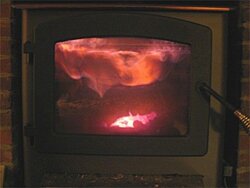I am looking to buy my first wood stove and have been sifting through the tons of info here on hearth. I have a 1300 sqft 2 story house that sits on top of an uninsulated block wall basement. House was built in 1921 so there is not much insulation anywhere else either. I plan to put the wood stove in the basement because we really have no place on the first floor for a wood stove and also have 2 small children that do not need to be around it. Our house is pretty small with a living room, dining room and kitchen on the first floor and 3 bedrooms and a bath on the second floor. I have registers already cut in the floor for the old oil forced air duct work that I plan to take down the ductwork and just leave the metal registers in the floor for heat transfer. I also will leave the basement door open for heat transfer. I think I have narrowed my choices down to the englander (summersheat) 50 snc13 or the 50 snc30. I know what all the numbers are as far as the square footage that it heats and the size of the firebox and such....but my question to you guys who would know alot more than me is this. Will the 13 be big enough to heat the whole house or should I opt for the 30? A little worried that the 30 might cook us out on the first floor since our house is so compact and our basement ceiling is only 6 foot. On the other hand the basement is unfinished and uninsulated and I anticipate heat loss, so maybe a 30 will be just right and the 13 would not be able to overcome the heat loss of a leaky house??? Please help. Thanks!
oh and i am planning a through the wall and up along the house with a stainless steel supervent chimney from lowes.
Jason
oh and i am planning a through the wall and up along the house with a stainless steel supervent chimney from lowes.
Jason


 Seriously, I hope that whatever you decide to do you do it safely and that it brings you the warmth in the wintertime that you're hoping to feel...and has the effect on your electric bill that you're hoping to achieve. Keep us informed here on how it goes. Rick
Seriously, I hope that whatever you decide to do you do it safely and that it brings you the warmth in the wintertime that you're hoping to feel...and has the effect on your electric bill that you're hoping to achieve. Keep us informed here on how it goes. Rick